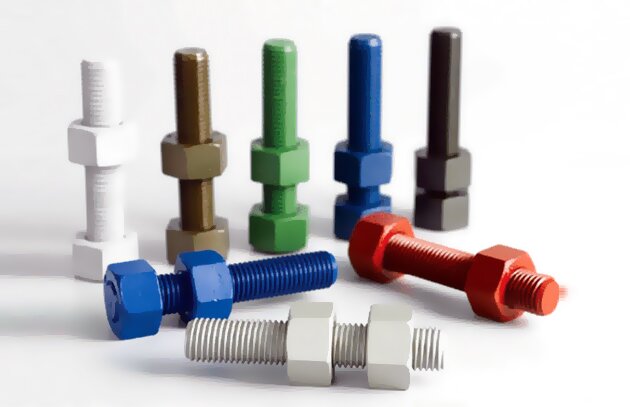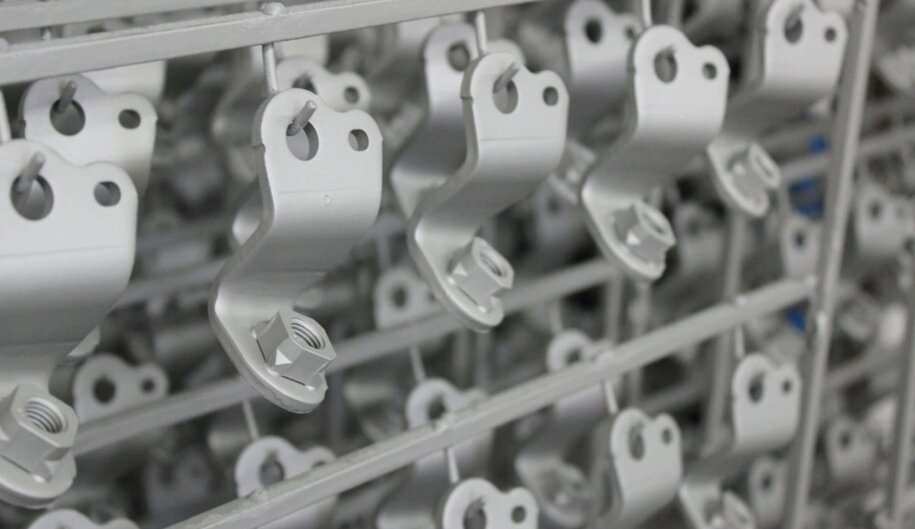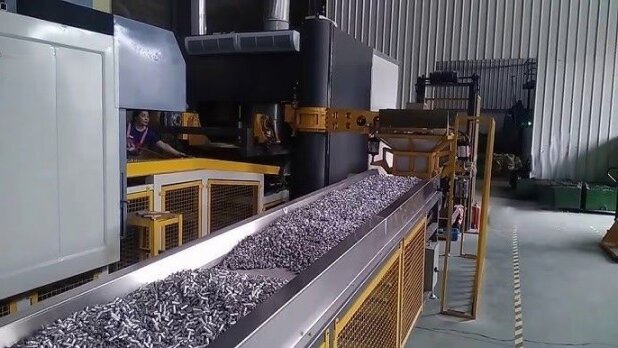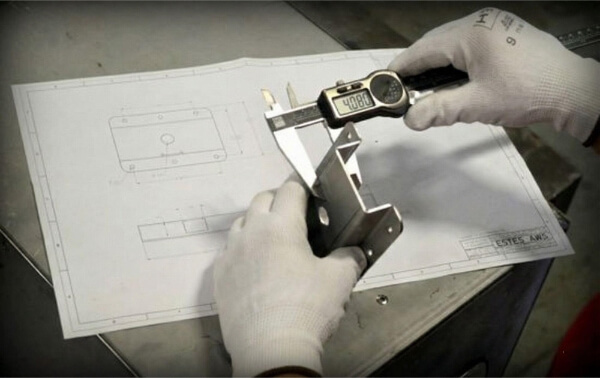Le parti metalliche sono costantemente minacciate da ruggine e corrosione, con conseguenti costose sostituzioni e manutenzioni. I rivestimenti protettivi tradizionali spesso non sono all'altezza, consumandosi rapidamente o fornendo una copertura inadeguata. Il rivestimento Dacromet risolve questi problemi con la sua formulazione unica di zinco-alluminio, offrendo una protezione superiore in diverse applicazioni industriali.
Volete sapere come questa tecnologia di rivestimento avanzata può prolungare la durata dei vostri componenti e ridurre i costi di manutenzione a lungo termine? Esaminiamo i dettagli tecnici, i vantaggi e le migliori applicazioni del rivestimento Dacromet.

Che cos'è il rivestimento Dacromet?
Il rivestimento Dacromet combina scaglie di zinco, polvere di alluminio e composti inorganici in una soluzione a base d'acqua. Questo sistema di rivestimento avanzato forma una barriera multistrato attraverso un preciso processo di applicazione a immersione seguito da un indurimento ad alta temperatura.
Pensate alla costruzione di uno scudo per le superfici metalliche, ma più intelligente dei rivestimenti tradizionali. Il processo inizia immergendo i pezzi nella miscela di rivestimento, facendoli ruotare per garantire una copertura uniforme e quindi polimerizzando a circa 300°C. In questo modo si crea uno strato protettivo spesso circa 7-8 μm.
Le particelle di zinco agiscono come guardiani sacrificali, subendo i colpi degli elementi corrosivi prima di raggiungere il metallo di base. Nel frattempo, le scaglie di alluminio creano una barriera fisica e il legante inorganico blocca il tutto controllando l'azione sacrificale dello zinco.
Tipi di rivestimento Dacromet
Applicazioni diverse richiedono livelli di protezione diversi e caratteristiche prestazionali specifiche. I produttori offrono diverse varianti di rivestimento Dacromet, ciascuna progettata per usi e condizioni ambientali particolari.
La base è costituita da scaglie di zinco-alluminio miscelate con leganti speciali per creare uno strato protettivo color argento. Questa formula di base costituisce la base per rivestimenti più specializzati.
Ecco una panoramica dei principali tipi:
Serie Dacromet:
- 310/320: Perfetto per elementi di fissaggio e sorgenti, utilizzando una formulazione a base di cromo esavalente
- 500: Presenta proprietà autolubrificanti, ideali per i componenti dell'industria automobilistica e dell'energia eolica.
Serie Geomet (senza cromo):
- 720: Costruito per elementi di fissaggio e parti automobilistiche, utilizzando la tecnologia a base di silicato
- 321: Offre una protezione affidabile per le applicazioni edilizie e automobilistiche
- 500: Include proprietà autolubrificanti per ridurre l'attrito
- 320/360: Contiene un maggior contenuto di alluminio per una maggiore resistenza al calore, specificamente progettato per i componenti dei freni
Il processo di rivestimento Dacromet
La trasformazione di parti metalliche grezze in componenti resistenti alla corrosione richiede un controllo preciso e attrezzature specializzate. Un processo di rivestimento di successo richiede un'attenta cura dei materiali, dei metodi di applicazione e delle misure di controllo della qualità.
Materiali utilizzati nel rivestimento Dacromet
La scelta dei materiali adatti è fondamentale per creare un rivestimento Dacromet efficace. Ogni componente svolge un ruolo specifico nello strato protettivo finale.
I materiali di base comprendono:
- Scaglie di zinco: Inibitore primario della corrosione
- Polvere di alluminio: migliora le proprietà di barriera
- Leganti inorganici: Bloccano le particelle metalliche in posizione
- Additivi specializzati: Controllo della viscosità e della fluidità
- Vettori a base d'acqua: Consentono una distribuzione uniforme
Processo di applicazione del rivestimento Dacromet passo dopo passo
Il processo di rivestimento segue una sequenza precisa:
Preparazione della superficie
- Pulire accuratamente le parti per rimuovere oli e contaminanti.
- Sabbiatura o trattamento chimico delle superfici per un'adesione ottimale
- Ispezionare i pezzi per verificarne la pulizia e il profilo superficiale
Applicazione del rivestimento
- Immergere le parti nella soluzione Dacromet
- Girare a velocità controllata per garantire una copertura uniforme
- Consentire l'essiccazione iniziale all'aria in condizioni controllate
Processo di polimerizzazione
- Riscaldare le parti a circa 300°C
- Mantenere la temperatura per una durata specifica
- Raffreddare in condizioni controllate

Vantaggi del rivestimento Dacromet
La tecnologia di protezione dei metalli è in continua evoluzione e il rivestimento Dacromet si distingue per i suoi vantaggi completi. Questa sezione illustra i principali vantaggi che rendono Dacromet la scelta preferita per la protezione dei metalli in tutti i settori industriali.
Maggiore resistenza alla corrosione
Il rivestimento Dacromet crea molteplici barriere contro gli elementi corrosivi grazie alla sua esclusiva struttura a strati. Le scaglie di zinco-alluminio formano uno scudo impenetrabile che blocca la penetrazione di umidità, sale e sostanze chimiche.
Caratteristiche principali della protezione:
- Resiste a oltre 1.000 ore di test in nebbia salina
- Previene la formazione di ruggine rossa
- Resiste all'esposizione chimica in ambienti industriali
Maggiore durata e longevità
La struttura multistrato del rivestimento Dacromet prolunga notevolmente la durata dei componenti. Questa durata si traduce in una minore frequenza di sostituzione e in minori costi di manutenzione.
Metriche di prestazione:
- Oltre 20 anni di vita utile in condizioni normali
- Elevata resistenza all'usura
- Forte adesione ai metalli di base
Resistenza alle alte temperature
Il Dacromet mantiene le sue proprietà protettive in un ampio intervallo di temperature. Questa stabilità termica lo rende adatto ai componenti esposti a cicli termici.
Prestazioni in termini di temperatura:
- Stabile fino a 300°C (572°F)
- Non si ammorbidisce e non si screpola con il calore
- Mantiene l'adesione durante le fluttuazioni di temperatura
Aspetti ecologici del rivestimento Dacromet
Il processo di rivestimento è in linea con i moderni standard ambientali. La formulazione a base d'acqua e i metodi di produzione riducono l'impatto ecologico.
Vantaggi verdi:
- Zero emissioni di VOC
- Conforme a REACH e RoHS
- Parti rivestite riciclabili
Requisiti di manutenzione ridotti
Una volta applicato, il rivestimento Dacromet richiede una manutenzione minima. Le proprietà autorigeneranti dello zinco garantiscono una protezione continua senza bisogno di manutenzione regolare.
Vantaggi della manutenzione:
- Non è necessaria una riverniciatura periodica
- Auto-riparazione di piccoli graffi
- Mantiene l'aspetto nel tempo
Svantaggi del rivestimento Dacromet
Estetica limitata
Il rivestimento produce una finitura grigia e opaca che potrebbe non essere adatta a tutte le applicazioni. Rispetto ad altri tipi di rivestimento, le opzioni di colore rimangono limitate.
Vulnerabilità ai danni meccanici
Nonostante le sue qualità protettive, il rivestimento Dacromet può essere danneggiato da forti urti o abrasioni. Anche oggetti appuntiti o carichi pesanti possono compromettere l'integrità del rivestimento.
Tempo di polimerizzazione più lungo rispetto ad altri rivestimenti
Il processo di applicazione multistrato richiede condizioni e tempi di indurimento specifici. Questo allunga i tempi di produzione rispetto a metodi di rivestimento più semplici.
Potenziale di spessore incoerente del rivestimento
La tecnica di applicazione influisce sull'uniformità del rivestimento. Le geometrie complesse dei pezzi possono comportare variazioni di spessore che influiscono sui livelli di protezione.
Costo iniziale dell'applicazione più elevato
Le attrezzature specializzate e il controllo del processo necessari per il rivestimento in Dacromet comportano costi iniziali più elevati. L'investimento iniziale deve essere valutato a fronte dei benefici a lungo termine.
Applicazioni del rivestimento Dacromet
Il rivestimento Dacromet serve diversi settori industriali in cui la protezione dei metalli contro gli ambienti difficili è fondamentale. Questa versatile soluzione di rivestimento soddisfa requisiti prestazionali specifici in vari settori, dall'automotive alle applicazioni marine.
Applicazioni per l'industria automobilistica
Il settore automobilistico fa grande affidamento sul rivestimento Dacromet per proteggere i componenti critici dal sale stradale, dall'umidità e dall'esposizione ambientale. Questo rivestimento aiuta i produttori a soddisfare i severi standard di durata e a ridurre le richieste di garanzia.
Applicazioni automobilistiche comuni:
- Componenti del sistema frenante
- Parti della sospensione
- Elementi di fissaggio del telaio
- Staffe di montaggio del motore
- Componenti del sistema di alimentazione
Utilizzi aerospaziali e militari
Nelle applicazioni aerospaziali e della difesa, il rivestimento Dacromet soddisfa rigorose specifiche di prestazione. Il rivestimento protegge i componenti esposti a condizioni estreme e a climi variabili.
Utilizzi chiave in campo militare e aerospaziale:
- Elementi di fissaggio strutturali
- Componenti del carrello di atterraggio
- Hardware esterno
- Attrezzature di supporto a terra
- Staffe di montaggio
Progetti di costruzione e infrastrutture
L'industria delle costruzioni apprezza il rivestimento Dacromet per la sua protezione a lungo termine dei componenti strutturali. Questo rivestimento contribuisce a prolungare la durata delle infrastrutture in ambienti difficili.
Le applicazioni edilizie comprendono:
- Componenti del ponte
- Parapetti autostradali
- Elementi di fissaggio per l'edilizia
- Strutture di supporto
- Giunti di dilatazione
Applicazioni marine
Gli ambienti marini richiedono una protezione anticorrosione superiore. Il rivestimento in Dacromet offre un'eccellente resistenza alla nebbia salina e all'esposizione costante all'umidità.
Il settore marino utilizza:
- Ferramenta per ponti
- Attrezzature portuali
- Piattaforme offshore
- Accessori per navi
- Componenti del contenitore

Rivestimento in Dacromet vs. rivestimento in Dacromet. Zincatura
La scelta corretta tra le opzioni di rivestimento influisce sia sulle prestazioni che sui costi. Questo confronto aiuta i decisori a selezionare la soluzione più adatta alle loro esigenze specifiche.
Differenze critiche nella resistenza alla corrosione
I due metodi di rivestimento offrono diversi livelli di protezione contro gli ambienti corrosivi. I test dimostrano che le prestazioni variano in modo significativo in condizioni difficili.
Confronto della resistenza alla corrosione:
- Dacromet: Oltre 1.000 ore di resistenza alla nebbia salina
- Zincatura: 200-300 ore di resistenza alla nebbia salina
Meccanismi di protezione:
- Dacromet crea più strati barriera
- La zincatura si basa su una protezione sacrificale
- I rischi di esposizione ai metalli di base differiscono in modo significativo
Costo-efficacia
I costi iniziali e il valore a lungo termine presentano scenari economici diversi per ogni tipo di rivestimento. Un'analisi approfondita rivela il vero impatto dei costi nel tempo.
Fattori di costo da considerare:
Dacromet:
- Investimento iniziale più elevato
- Riduzione dei costi di manutenzione
- Vita utile prolungata
Zincatura:
- Costi iniziali più bassi
- È necessaria una riverniciatura più frequente
- Maggiori spese a lungo termine
Confronto tra durata e prestazioni
Le prestazioni reali differiscono in modo significativo tra queste opzioni di rivestimento. Le condizioni ambientali e i requisiti di applicazione influenzano la durata del rivestimento.
Metriche di prestazione:
Resistenza alla temperatura:
- Dacromet: Fino a 300°C
- Zincatura: Fino a 120°C
Consistenza dello spessore:
- Dacromet: Copertura uniforme
- Zincatura: Accumulo variabile
Resistenza agli urti:
- Dacromet: Flessibilità moderata
- Zincatura: Più fragile
Resistenza chimica:
- Dacromet: Alta resistenza
- Zincatura: Resistenza moderata
Conclusione
Il rivestimento Dacromet dimostra il suo valore grazie a una protezione anticorrosione superiore e a vantaggi economici a lungo termine. Sebbene l'investimento iniziale possa essere più elevato, la maggiore durata e la minore manutenzione ne fanno una scelta intelligente per le applicazioni più impegnative. La conformità ambientale del rivestimento e la sua comprovata esperienza nei vari settori industriali lo rendono una soluzione affidabile per le moderne sfide produttive.
Oltre al rivestimento Dacromet, offriamo soluzioni complete di produzione personalizzata per tutte le vostre esigenze. Grazie ad attrezzature avanzate e ad un team tecnico professionale, siamo in grado di soddisfare le vostre diverse esigenze in Lavorazione CNC, fabbricazione di lamieree altro ancora. Sceglieteci per rendere il vostro processo produttivo più efficiente e continuo.
Domande frequenti
Quanto dura il rivestimento Dacromet?
In condizioni normali, il rivestimento Dacromet dura in genere 20-25 anni. La durata effettiva dipende dall'esposizione ambientale e dalle condizioni di applicazione. Ispezioni regolari aiutano a monitorare le prestazioni del rivestimento nel tempo.
Il rivestimento Dacromet può essere applicato a tutti i materiali?
Il rivestimento Dacromet funziona al meglio su substrati di acciaio e ferro. Anche se può essere applicato ad altri metalli, il processo di rivestimento richiede condizioni superficiali e metodi di preparazione specifici per garantire una corretta adesione.
Il rivestimento Dacromet è sicuro per l'ambiente?
La formulazione a base d'acqua non contiene metalli pesanti o solventi nocivi. Il rivestimento Dacromet soddisfa le normative ambientali vigenti in tutto il mondo, compresi gli standard REACH e RoHS. Il processo produce rifiuti ed emissioni minime.
Il Dacromet contiene cromo esavalente?
No, il rivestimento Dacromet non contiene cromo esavalente. Utilizza invece composti di cromo trivalente, il che lo rende conforme ai moderni standard ambientali e di sicurezza.
Qual è lo spessore del rivestimento del Dacromet?
Lo spessore standard del rivestimento Dacromet varia da 5 a 15 micron. Lo spessore esatto dipende dai requisiti dell'applicazione e dal livello di qualità specificato. Le misure di controllo della qualità assicurano uno spessore uniforme del rivestimento su tutti i pezzi.
Ciao, sono Kevin Lee

Negli ultimi 10 anni mi sono immerso in varie forme di lavorazione della lamiera, condividendo qui le mie esperienze in diverse officine.
Contattate

Kevin Lee
Ho oltre dieci anni di esperienza professionale nella fabbricazione di lamiere, con specializzazione nel taglio laser, nella piegatura, nella saldatura e nelle tecniche di trattamento delle superfici. In qualità di direttore tecnico di Shengen, mi impegno a risolvere sfide produttive complesse e a promuovere innovazione e qualità in ogni progetto.




